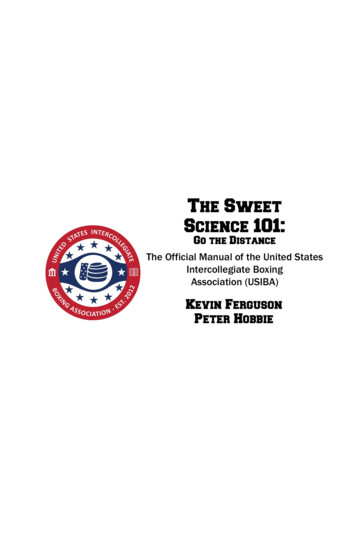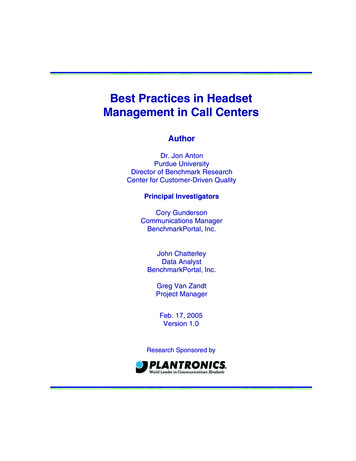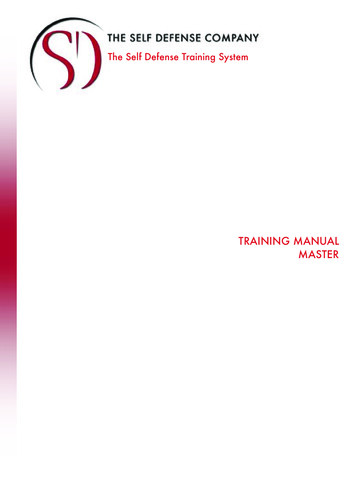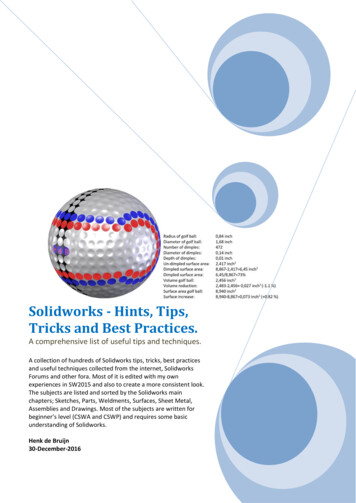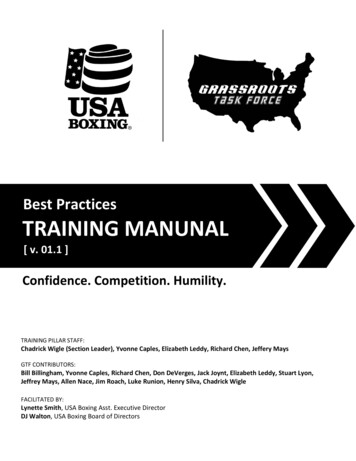
Transcription
Best PracticesTRAINING MANUNAL[ v. 01.1 ]Confidence. Competition. Humility.TRAINING PILLAR STAFF:Chadrick Wigle (Section Leader), Yvonne Caples, Elizabeth Leddy, Richard Chen, Jeffery MaysGTF CONTRIBUTORS:Bill Billingham, Yvonne Caples, Richard Chen, Don DeVerges, Jack Joynt, Elizabeth Leddy, Stuart Lyon,Jeffrey Mays, Allen Nace, Jim Roach, Luke Runion, Henry Silva, Chadrick WigleFACILITATED BY:Lynette Smith, USA Boxing Asst. Executive DirectorDJ Walton, USA Boxing Board of Directors
INTRODUCTIONAbout the Grassroots Task ForceBrought together in 2013 by the National office, the Grassroots Task Force is a working group ofvolunteers assembled by USA Boxing to provide performance and financial benefits to the 1,500registered boxing clubs. Our sole purpose is to support our membership by providing valuableinformation that will enhance every aspect of running an amateur boxing program. To learn moreabout the GTF or to volunteer, please contact:Grassroots@USABoxing.orgPreambleThe Training Pillar of the Grassroots Manual has been developed with the understanding that noempirical “best” exists when it comes to the sport of boxing. Efficacy is the only standard that mattersand methods will vary from coach to coach and fighter to fighter. The primary purpose of theGrassroots Training Pillar is to share successful boxing methodologies with new and seasoned coachesalike. This manual focuses on the standardization of fundamentals while allowing for individualcoaches to develop their own unique competitive style.As the saying goes, “Styles make fights.” Styles vary because fighters and coaches vary. Each has theirparticular preferences and aversions. Every fighter possess his own specific set of strengths andweaknesses. Often, success is a matter of matching the athlete with the coach whose training methodcan best develop that athlete’s innate abilities. Ten different coaches can teach the jab ten differentways. If the jab is effective, then the instruction is valid.In our sport, words mean nothing without a person to bring them to life. Please feel free to adopt whatyou consider useful in any order you wish. The choice of how to proceed is completely yours.Manual topics include:»Coaching, training, and teaching methodologies»Techniques, tactics and strategies»Athlete motivation»Competition preparation»Developing the team’s support structure»Summary of new rules (effective January 2014)»The Art of Boxing as recreation for all ages and demographics»detailed guides for skill analysis, day/week planning, and sparring sessions»Advances techniques and tactics from around the worldPage 1Grassroots Task Force Training Manual v.01 (2014)
»Suggested reading about coaching, strength and conditioning, nutrition, etc.A TRIBUTE TO SARGEThe Training Pillar of the Grassroots Manual isdedicated to the coaches who helped contribute toUSA Boxing’s success. It is our humble hope that ourwork helps in some small way to contribute to thecontinuance of the storied legacy of USA Boxing.Amateur boxing is advancing by returning the practicesthat made boxing one of the biggest sports in theworld. Scoring will be determined by the familiar 10point must system and headgear will no longer be arequirement for experienced fighters. The last timeTeam USA fought for Gold without headgear was the1976 Montreal Olympics where they earned 7 medals5 gold, 1 silver, and 1 bronze. We hope this changeportends even greater success for Team USA as theyagain fight for Gold. This time in 2016 Olympics in Brazil.The United States amateur boxing community receiveda devastating blow on March 14, 1980 when 14 boxers,along with their coaches and administrative staff,perished in a plane crash on the outskirts of theWarsaw International Airport in Poland. Lost amongthem was Coach Thomas “Sarge” Johnson (picturedwith the 1976 Olympic team, front, middle right).Commenting on the loss, “Sugar” Ray Leonard said,“He was one of the kindest, fairest men I’ve known.He was just beginning to get the recognition hedeserved. He was really the one who put togetherthose five gold medals.”While this manual is dedicated to all the coaches thathave built USA Boxing, the Grassroots team would liketo extend special recognition to Coach Sarge Johnson.May his shining example inspire you, the futuremakers of champions, to even greater success andglory for Team USA.Page 2Grassroots Task Force Training Manual v.01 (2014)
TABLE OF CONTENTS❶ CHAPTER 1: COACHESDEFINITIONS The Coach The Secondo Eligibilityo Duties of the Secondo Prohibited ActivitiesPage 09USA BOXING COACH LEVELS & REQUIREMENTS Coach Level 1 Coach Level 2 Coach Level 3Page 11SKILLS AND RESPONSIBILITIESPage 11COACHING STYLES Authoritarian Coaching (Autocratic Style) Co-operative Coaching (Democratic Style) Casual CoachingPage 12THE COACH INSIDE THE SPORT SYSTEM Code of Conduct for Coaches The Sport System (flow chart) Positive Relations Inside the SystemPage 12PREVENTING COACH BURNOUT Tips Prehab Exercises, Stretches, and more Develop a Personal Vision/Purpose StatementPage 15THE COACH-PARENT/VOLUNTEER RELATIONSHIP Parent/Volunteer Educationo Generalo Specific Parents/Volunteers as Valuable AssetsPage 18SUGGESTED READINGS FOR COACHESPage 20Page 3Grassroots Task Force Training Manual v.01 (2014)
❷ CHAPTER 2: TRAININGTRAINING WITH BEGINNERS Training StagesPage 22GROUP COACHING Teaching and Training MethodsPage 25ORGANIZING TRAINING SESSIONS Facility Equipment Preparing Training ProgramsPage 29BOXING TECHNIQUES Boxing Stance Boxing Steps Basic Punches Basic Defenses Combinations of Punches Feinting Boxing in Various DistancesPage 34PHYSICAL TRAINING Endurance Strength Speed CoordinationPage 65ADVANCED TRAINING Isometric Training Plyometric Training Over TrainingPage 67TACTICAL TRAINING Boxing against different character boxers change to different boxing types Boxing on the ropes and in the cornerPage 69SPARRING Safe Sparring Practices Types of Sparring Monitoring Sparring Sessions Appropriate Sparring SchedulesPage 73TRAINING WITHOUT EQUIPMENT Endurance Training Strength Training Speed Training Coordination TrainingPage 77Page 4Grassroots Task Force Training Manual v.01 (2014)
ATHLETE MOTIVATIONPage 77RECOVERYPage 78EVALUATION Training Sessions Technical Development Physical Development Tactical DevelopmentPage 79ADVANCED TECHNIQUES – USA Boxing Stance Footwork Attacks Defenses Training Plan Development Past USA Boxing Elite Super StarsPage 81SUMMARIES OF ADVANCED INTERNATIONAL STYLES Cuba Russia EuropePage 96INDIVIDUALIZATIONPage 97 Purpose of Individualization Training Steps to Develop the Individualized Training Plan Individualization of Young Boxers Natural Characteristics and Growth of Boxers Experience Appropriate to the Development Analysis of Performance Related to the Development Identification and Utilization of Methods for Development, Training and Conditioning Analysis of the Boxer’s Interest and Abilities to Box Control and Monitoring of TrainingSUGGESTED READINGS FOR TRAININGPage 5Grassroots Task Force Training Manual v.01 (2014)Page 99
❸ CHAPTER 3: COMPETITIONPRIOR TO THE COMPETITIONPage 101DURING THE COMPETITIONPage 102AFTER THE COMPETITIONPage 105RULES AND REGULATIONS (with USA Boxing Rules)Page 105 Age Classification & Weight Categories (as per USA COMP rules)Eligibility of Boxers (as per USA COMP Rules)Duration and Number of Rounds (as per USA COMP Rules)Manual Scoring (as per USA TECH Rules)Fouls (as per USA Tech Rules)The Decision (as per USA TECH Rules)The Field of Play (FOP)HeadgearBandages/Hand WrapsSUGGESTED READINGS FOR COMPETITIONSPage 110❹ CHAPTER 4: ADDITIONAL ASPECTS IN BOXINGMEDICAL Injuries Injury Prevention Treatment for minor injuries Treatment for severe injuriesPage 112NUTRITIONPage 115WEIGHT MONITORINGPage 116BREATHINGPage 117SUGGESTED READINGS FOR ADDITIONAL ASPECTSPage 118Page 6Grassroots Task Force Training Manual v.01 (2014)
❺ CHAPTER 5: THE ART OF BOXINGTHE SPORT AND THE ART OF BOXINGPage 120DISTINCT POPULATIONSPage 120 AgeRecreational Group InstructorRecreational Private InstructorBoxing Training for Mixed Martial Arts❻ CHAPTER 6: STEP-BY-STEP GUIDESTRAINING SUGGESTIONS BY AGE GROUPPage 123HOW SAFE IS AMATEUR BOXING?Page 126INGREDIENTS & RECIPES FOR Page 130 A Day PlanDrill Design/Sparring SessionEXAMPLE LESSON PLANS Page 131Day PlanWeekMANAGING COMPETITION INJURIES FOR SECONDSPage 132SKILL ANALYSIS FROM THE GROUND UPPage 133 Example Skill ChecklistsRESOURCES USED IN THIS MANUALPage 141APPENDIXAppendix A: Strength & Coordination Training Exercise ExamplesPage 144Appendix B: Plyometric Training Exercises ExamplesPage 149Appendix C: Isometric Training Exercises ExamplesPage 155Appendix D: Physical Development Evaluation ExamplesPage 158Appendix E: Coaching Tools (Blank Drill Sheets, Day Plan, Week Plan)Page 166Appendix F: Coach’s Prehab Exercise ExamplesPage 169Appendix G: Sample New Boxer HandoutsPage 171Appendix H: Medical FormsPage 180Appendix I: Sample Drills from AIBA Peace & Sport ManualPage 185Page 7Grassroots Task Force Training Manual v.01 (2014)
Chapter 1COACHESPage 8Grassroots Task Force Training Manual v.01 (2014)
DEFINITIONSThe CoachThe coach is a teacher, a role-model and a friend in boxing who willorganize, supervise and conduct the training to help to reach the athlete’s best potential.“All coaching is, is taking a player where he can’t take himself.”– Bill McCartney (American Football Coach)“I think parenting and coaching or teaching are the same thing. And they are thetwo most important professions in the world.”– John Wooden (Basketball Coach)“A good coach will make his players see what they can be rather than what theyare”– Ara Parasheghian (American Football Coach)The SecondWhen the coach enters into the Field of Play (FOP), he/she shall be referred to as theSecond. The Second has to be a coach who takes care of a boxer before, during and afterthe bout. He/she must follow the USA Boxing Rules and Regulations. The second’s firstpriority is the safety of the boxer.Eligibility of the Coach and/or Second (as per USA Boxing Technical Rules) Only USA Boxing certified Coaches can work as Seconds in all USA Boxing Competitions. A registered Boxer may serve as a second, and remain on the floor if two certified coaches arepresent, or may mount the ring apron if there is only one certified second Each Boxer will be entitled to be accompanied to the ring by up to three (3) Seconds. However,only two (2) Seconds may mount the apron of the ring and only one (1) may enter the ring. (Only for international AIBA AOB competitions) Any Coach active in professional boxing will not beallowed to be a Coach and/or Second in AIBA Competitions at any level unless this Coach hasresigned from any involvement in professional boxing for a period of at least six (6) months and iscertified by AIBA as a registered Coach. (this does not pertain to domestic events, includingNationals)The Duties of Seconds are as follows: Seconds must leave the ring and the apron prior to the start of each round, and must remove seats,towels, buckets, etc., from the platform of the ring. Seconds must be in possession of a towel and may use it to indicate retirement by throwing thetowel into the ring at any time except when the referee is counting Seconds can only use a transparent water bottle. In the case of a cut, the Seconds can use:Page 9Grassroots Task Force Training Manual v.01 (2014)
The Duties of Seconds (Cont’d): Avitene – is a hemostatic agent (a substance that promotes hemostasis; stops bleeding) for bloodcoagulation and comes in two (2) forms; powder or sponge. It is stable at room temperature and isnot sensitive to light. Apply the sponge directly to the cut with direct pressure, or suspend the flourin 0.5% saline solution and use a sterile cotton swab with direct pressure.(Flexible) Collodion – used as a topical protectant, applied to the skin to close small wounds,abrasions and cuts, and to keep medications in contact with the skin. It is found in a variety ofproducts. NOTE: be sure to use medical/first aid grade collodion; DO NOT use theatrical collodion.Thrombin Solution – is a hemostatic agent for blood coagulation. You will need a prescription from adoctor, and it must be refrigerated. Use a sterile cotton swab to apply with direct pressure.Microfibrillar Collagen – same as Avitene ; see aboveGelfoam – is a Thrombin solution based dressing used to stop bleeding in open wounds and helpsto form a clotSurgicel - is a hemostatic agent in the form of an absorbable knitted fabric, prepared by controlledoxidation of celluloseAdrenaline 1/1000 – is a hemostatic agent for blood coagulation. You will need a prescription from adoctor. It must be stored at room temperature and is light sensitive. Apply with a sterile cotton swaband direct pressure.Ice bags, No-Swell, Vaseline and Swabs are permissible.Prohibited Activities Seconds will not be permitted to shout, to clap to the Boxer and/or the Referee, to encourage orincite spectators by words or signs during the progress of a round. Seconds will not be allowed totouch the ring during the Bout, or disturb the competition.Seconds’ seating area must be 3 feet away from the ring corner within 6 feet squared. Seconds willnot be permitted to walk off Second’s designated area as a protest for disagreed actions against theReferee.Seconds will not be permitted to act in an unsportsmanlike mannerThe use of any communication device will not be permitted in the FOPPage 10Grassroots Task Force Training Manual v.01 (2014)
USA BOXING COACH LEVELS & REQUIREMENTSCoach Level 1 Coach Level 2 Coach Level 3 Registered with USA BoxingMust be at least 18 years oldCompleted Level 1 Certification Clinic and pass test with score of more than 70%Registered with USA BoxingMust be at least 18 years oldCompleted L
ORGANIZING TRAINING SESSIONS Page 29 Facility Equipment Preparing Training Programs . BOXING TECHNIQUES. Page 34 Boxing Stance Boxing Steps Basic Punches Basic Defenses Combinations of Punches Feinting Boxing in Various Distances . PHYSICAL TRAINING Page 65 Endurance Strength Speed

